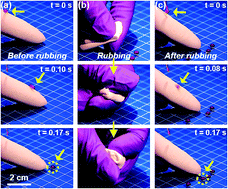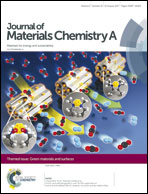A highly stretchable and robust non-fluorinated superhydrophobic surface†
Abstract
A superhydrophobic surface simultaneously possessing exceptional stretchability, robustness, and non-fluorination is highly desirable in applications ranging from wearable devices to artificial skins. While conventional superhydrophobic surfaces typically feature stretchability, robustness, or non-fluorination individually, co-existence of all these features still remains a great challenge. Here we report a multi-performance superhydrophobic surface achieved through incorporating hydrophilic micro-sized particles with a pre-stretched silicone elastomer. The commercial silicone elastomer (Ecoflex) endowed the resulting surface with high stretchability; the densely packed micro-sized particles in multiple layers contributed to the preservation of the high surface roughness even under large strains; and the physical encapsulation of the microparticles by the silicone elastomer due to the capillary dragging effect and the chemical interaction between the hydrophilic silica and the elastomer gave rise to the robust and non-fluorinated superhydrophobicity. It was demonstrated that the as-prepared fluorine-free surface could preserve the superhydrophobicity under repeated stretching–relaxing cycles. Most importantly, the surface's superhydrophobicity could be well maintained after a severe rubbing process, indicating wear-resistance. Our novel superhydrophobic surface integrating multiple key properties, i.e. stretchability, robustness, and non-fluorination, is expected to provide unique advantages for a wide range of applications in biomedicine, energy, and electronics.

- This article is part of the themed collection: Green Materials and Surfaces


 Please wait while we load your content...
Please wait while we load your content...